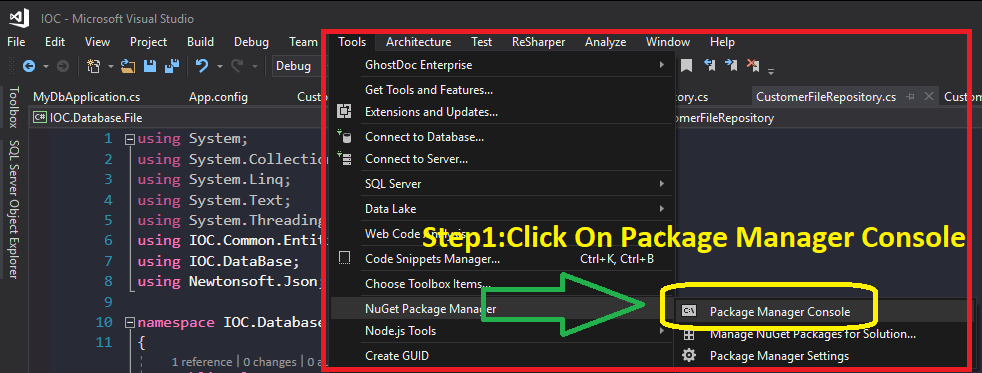I am trying to run my tests on TeamCity which is currently installed on my machine.
System.InvalidOperationException:The Entity Framework provider type '
System.Data.Entity.SqlServer.SqlProviderServices, EntityFramework.SqlServer,Version=6.0.0.0, Culture=neutral, PublicKeyToken=b77a5c561934e089'for the 'System.Data.SqlClient' ADO.NET provider could not be loaded. Make sure the provider assembly is available to the running application.See http://go.microsoft.com/fwlink/?LinkId=260882 for more information..
I have no reference to System.Data.Entity in any of my projects as was suggested on codeplex for upgrading to EF6.
So, I am not sure why am I getting this exception. I do not get any such exception when I run the tests from VS.
I did try to set CopyLocal to false then again to true.. but that does not seem to work either.
Update
My app.config has the following . Does this cause some behavior that I don't understand ?
<?xml version="1.0" encoding="utf-8"?>
<configuration>
<configSections>
<section name="entityFramework" type="System.Data.Entity.Internal.ConfigFile.EntityFrameworkSection, EntityFramework, Version=6.0.0.0, Culture=neutral, PublicKeyToken=b77a5c561934e089" requirePermission="false" />
<!-- For more information on Entity Framework configuration, visit http://go.microsoft.com/fwlink/?LinkID=237468 -->
</configSections>
<entityFramework>
<defaultConnectionFactory type="System.Data.Entity.Infrastructure.SqlConnectionFactory, EntityFramework" />
</entityFramework>
</configuration>
I get the following stacktrace in teamcity .
[MSTest] IntegrationTests.CrudTest+QuestionTest.Create
[03:59:11][IntegrationTests.CrudTest+QuestionTest.Create] Initialization method IntegrationTests.CrudTest+QuestionTest.Initialize threw exception. System.InvalidOperationException: System.InvalidOperationException: The Entity Framework provider type 'System.Data.Entity.SqlServer.SqlProviderServices, EntityFramework.SqlServer, Version=6.0.0.0, Culture=neutral, PublicKeyToken=b77a5c561934e089' for the 'System.Data.SqlClient' ADO.NET provider could not be loaded. Make sure the provider assembly is available to the running application. See http://go.microsoft.com/fwlink/?LinkId=260882 for more information..
[03:59:11]
[IntegrationTests.CrudTest+QuestionTest.Create] at System.Data.Entity.Config.ProviderServicesFactory.GetInstance(String providerTypeName, String providerInvariantName)
at System.Data.Entity.Config.ProviderServicesFactory.GetInstanceByConvention(String providerInvariantName)
at System.Data.Entity.Config.DefaultProviderServicesResolver.GetService(Type type, Object key)
at System.Data.Entity.Config.CachingDependencyResolver.<>c__DisplayClass1.<GetService>b__0(Tuple`2 k)
at System.Collections.Concurrent.ConcurrentDictionary`2.GetOrAdd(TKey key, Func`2 valueFactory)
at System.Data.Entity.Config.CachingDependencyResolver.GetService(Type type, Object key)
at System.Data.Entity.Config.ResolverChain.<>c__DisplayClass3.<GetService>b__0(IDbDependencyResolver r)
at System.Linq.Enumerable.WhereSelectArrayIterator`2.MoveNext()
at System.Linq.Enumerable.FirstOrDefault[TSource](IEnumerable`1 source, Func`2 predicate)
at System.Data.Entity.Config.ResolverChain.GetService(Type type, Object key)
at System.Data.Entity.Config.RootDependencyResolver.GetService(Type type, Object key)
at System.Data.Entity.Config.ResolverChain.<>c__DisplayClass3.<GetService>b__0(IDbDependencyResolver r)
at System.Linq.Enumerable.WhereSelectArrayIterator`2.MoveNext()
at System.Linq.Enumerable.FirstOrDefault[TSource](IEnumerable`1 source, Func`2 predicate)
at System.Data.Entity.Config.ResolverChain.GetService(Type type, Object key)
at System.Data.Entity.Config.CompositeResolver`2.GetService(Type type, Object key)
at System.Data.Entity.Config.IDbDependencyResolverExtensions.GetService[T](IDbDependencyResolver resolver, Object key)
at System.Data.Entity.Config.InternalConfiguration.GetService[TService](Object key)
at System.Data.Entity.Config.DbConfiguration.GetService[TService](Object key)
at System.Data.Entity.Utilities.DbProviderFactoryExtensions.GetProviderServices(DbProviderFactory factory)
at System.Data.Entity.Infrastructure.DefaultManifestTokenService.GetProviderManifestToken(DbConnection connection)
at System.Data.Entity.Utilities.DbConnectionExtensions.GetProviderInfo(DbConnection connection, DbProviderManifest& providerManifest)
at System.Data.Entity.DbModelBuilder.Build(DbConnection providerConnection)
at System.Data.Entity.Internal.LazyInternalContext.CreateModel(LazyInternalContext internalContext)
at System.Data.Entity.Internal.RetryLazy`2.GetValue(TInput input)
at System.Data.Entity.Internal.LazyInternalContext.InitializeContext()
at System.Data.Entity.Internal.InternalContext.GetEntitySetAndBaseTypeForType(Type entityType)
at System.Data.Entity.Internal.Linq.InternalSet`1.Initialize()
at System.Data.Entity.Internal.Linq.InternalSet`1.get_InternalContext()
at System.Data.Entity.Internal.Linq.InternalSet`1.ActOnSet(Action action, EntityState newState, Object entity, String methodName)
at System.Data.Entity.Internal.Linq.InternalSet`1.Add(Object entity)
at System.Data.Entity.DbSet`1.Add(TEntity entity)
at EFRepository.Infrastructure.EFRepository`1.Add(T item) in c:\TeamCity\buildAgent\work\da2ea4e72c0e77f0\Repository\Infrastructure\EFRepository.cs:line 22
at IntegrationTests.CrudTest.Initialize() in c:\TeamCity\buildAgent\work\da2ea4e72c0e77f0\IntegrationTests\CrudTest.cs:line 34




private volatile Type _dependency...answer and it worked! It just stinks that I have to add a separate class like this just to get EF to work in TeamCity. – Rubin